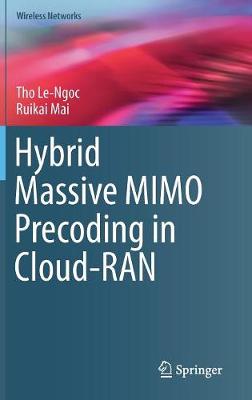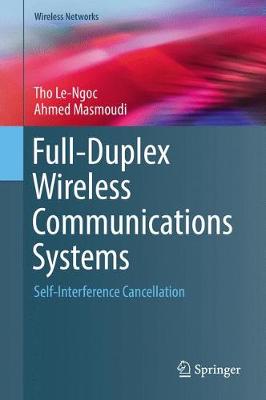Wireless Networks
3 total works
This book covers the design and optimization of hybrid RF-baseband precoding for massive multiple-input multiple-output (MIMO)-enabled cloud radio access networks (RANs), where use cases such as millimeter-wave wireless backhauling, fully-loaded cellular networks are of interest. The suitability and practical implementation of the proposed precoding solutions for the Cloud RAN architecture are also discussed.
Novel techniques are examined for RF precoding optimization in combination with nonlinear precoding at baseband, and the superiority of joint RF-baseband design is verified. Moreover, the efficacy of hybrid RF-baseband precoding to combat intercell interference in a multi-cell environment with universal frequency reuse is investigated, which is concluded to be a promising enabler for the dense deployment of base stations.This book mainly targets researchers and engineers interested in the challenges, optimization, and implementation of massive MIMO precoding in 5G Cloud RAN. Graduate students in electrical engineering and computer science interested in the application of mathematical optimization to model and solve precoding problems in massive MIMO cellular systems will also be interested in this book.
Full-Duplex Wireless Communications Systems
by Tho Le-Ngoc and Ahmed Masmoudi
This book introduces the development of self-interference (SI)-cancellation techniques for full-duplex wireless communication systems. The authors rely on estimation theory and signal processing to develop SI-cancellation algorithms by generating an estimate of the received SI and subtracting it from the received signal.
The authors also cover two new SI-cancellation methods using the new concept of active signal injection (ASI) for full-duplex MIMO-OFDM systems. The ASI approach adds an appropriate cancelling signal to each transmitted signal such that the combined signals from transmit antennas attenuate the SI at the receive antennas. The authors illustrate that the SI-pre-cancelling signal does not affect the data-bearing signal.
This book is for researchers and professionals working in wireless communications and engineers willing to understand the challenges of deploying full-duplex and practical solutions to implement a full-duplex system. Advanced-level students in electrical engineering and computer science studying wireless communications will also find this book useful as a secondary textbook.
Learning-Based Reconfigurable Multiple Access Schemes for Virtualized MTC Networks
by Tho Le-Ngoc and Atoosa Dalili Shoaei
Machine-type communications are expected to account for the dominant share of the traffic in future wireless networks. While in traditional wireless networks, designed for human-type communications, the focus is on support of large packet sizes in downlink, machine-type communication systems deal with heavy uplink traffic. This is due to the nature of the tasks performed by machine-type communication devices, which is mainly reporting measured data or a detected event. Furthermore, in these networks, using the virtualization framework, the network infrastructure can be shared between different applications for which providing isolation is of high importance. To support these unique characteristics of machine-type communications, proper access schemes need to be developed, which is the focus of this book.
This book benefits advanced-level students studying computer science and electrical engineering as a secondary textbook and researchers working in this field. Engineers and practitioners interested in the challenges and practical solutions of integrating MTC in the cloud radio access network of 5G-and-beyond cellular systems will want to purchase this book as well.


